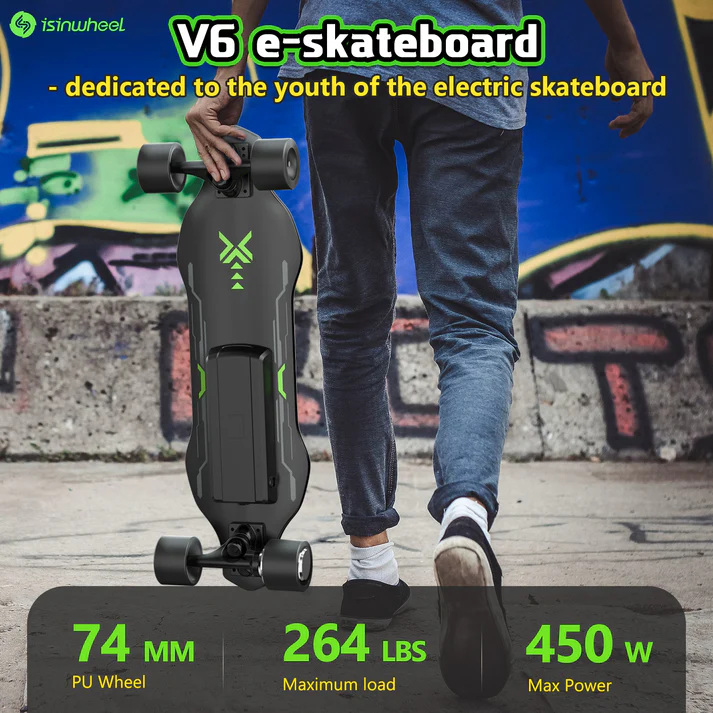Skateboard Types
There are several different types of electric skateboards available on the market today. Each type offers a unique riding experience and has its own control set. It’s important to understand the specific type of electric skateboard you use to control it effectively.

Electric skateboards
- Dual Motor Boards: Dual motor electric skateboards have two motors, one on each wheel, providing extra power and acceleration. The controls for dual motor boards are usually similar to longboards, with a handheld remote controlling speed, braking, and switching between different riding modes. Some dual motor boards may also have a regenerative braking feature, which utilizes the motors to recharge the battery while slowing down.
- Single Motor Boards: Single-motor electric skateboards have one motor attached to the front or rear wheel. These boards are typically more affordable and offer a more straightforward riding experience. The controls for single motor boards are similar to those of dual motor boards, with a handheld remote controlling speed and braking. Some single motor boards might not have different riding modes, but they still provide a thrilling riding experience.
- Hub Motor Boards: Hub motor electric skateboards have the motor embedded directly inside the wheel. This design creates a sleek and compact look and a smoother riding experience. Hub motor boards often have wireless handheld remotes controlling speed and braking. Some models even come with regenerative braking, allowing you to recharge the battery as you slow down.
Electric Skateboard Components
On the other hand, electric skateboards offer a motorized alternative to traditional skateboards, enhancing control and providing an exhilarating riding experience. Understanding the components of an electric skateboard is essential for effectively controlling it.
Motor
The motor is the heart of an electric skateboard and propels the rider forward. Most electric skateboards feature a hub motor or a belt-driven motor.
- Hub Motor: Hub motors are integrated into the skateboard’s wheels, providing a sleek and compact design. Compared to belt-driven motors, they offer a quieter ride and require less maintenance. Controlling a skateboard with a hub motor is typically done through a handheld remote that allows you to adjust the speed and activate the brakes.
- Belt-Driven Motor: On the other hand, Belt-driven motors use a belt and pulley system to transfer power from the motor to the wheels. This design allows for higher torque and faster acceleration. The control method can vary with a belt-driven motor depending on the skateboard model. It can be a handheld remote, a wireless controller worn on the wrist, or even a smartphone app.
Battery
The battery is another crucial component of an electric skateboard, as it powers the motor. It is typically located within the deck or in a separate housing on the underside of the skateboard. The battery capacity can vary depending on the model, with higher-capacity batteries providing longer riding distances.
To control an electric skateboard, it is important to understand the battery life and how to manage it effectively. Most electric skateboards come with a battery indicator that displays the remaining charge. It is essential to monitor this indicator and recharge the battery when necessary to avoid running out of power during a ride.
Charging the battery is simple. Most electric skateboards come with a charger that plugs into a standard electrical outlet. The charging time can vary depending on the battery capacity, but it generally takes a few hours to recharge fully. It is recommended to follow the manufacturer’s charging guidelines to ensure the battery’s longevity and performance.
Some electric skateboards also feature regenerative braking, which means that when you apply the brakes, the motor acts as a generator and converts the kinetic energy back into electric power to recharge the battery. This feature helps extend the riding range by maximizing the battery’s efficiency.
Control center
The control center of an electric skateboard is where all the magic happens. This is where you, as the rider, have full control over the skateboard’s speed, braking, and other functionalities.
- Handheld Remote: Many electric skateboards have a handheld remote that allows you to control the speed and braking. The remote usually has a throttle wheel or a trigger that you can push or pull to accelerate or decelerate, respectively. Some remotes also have additional features, such as a reverse button or different customizable riding modes.
- Wireless Controller: Another popular control method is a wireless controller worn on the wrist. This controller usually has buttons or a touch-sensitive surface that you can use to control the skateboard. The advantage of a wrist controller is that it leaves your hands free, allowing for a more natural riding experience. It also eliminates the risk of dropping the remote while riding.
- Smartphone App: Some electric skateboards can be controlled through a smartphone app for those who prefer a more tech-savvy approach. The app connects to the skateboard via Bluetooth and provides a user-friendly interface to control the speed, braking, and other features. With the smartphone app, riders can easily adjust the speed settings, change riding modes, and even track their riding statistics, such as distance traveled and battery level.

Control Options for Electric Skateboards
Remote controls
Electric skateboard with remote controls are one of the most common and convenient ways to control an electric skateboard. They are compact, lightweight, and easy to use, allowing riders complete control over their ride.
Handheld remotes are the most popular type of remote control for electric skateboards. They typically have a throttle wheel or a trigger that you can push or pull to accelerate or decelerate. Some remotes also have additional buttons or features, such as a reverse button or different riding modes for customization. These remotes are held in your hand while riding, allowing quick and easy access to control your skateboard’s speed and braking.
Smartphone controllers
Utilizing the smartphone app, riders can effortlessly fine-tune the speed settings of their electric skateboard to cater to their preferred comfort level or riding style. This allows for unlimited control over the pace of the ride, whether you desire to go lightning-fast or take it slow and steady.
In addition to speed adjustments, the smartphone app also allows riders to change riding modes. Electric skateboards often come with different modes such as beginner, eco, and pro. These modes modify the acceleration and top speed of the skateboard, catering to riders of varying skill levels or preferences. Using the smartphone app, you can easily switch between these modes with just a few taps on your screen.
Universal remotes
While smartphone apps provide a convenient way to control and update your electric skateboard, some riders may prefer a more traditional approach. This is where universal remotes come into play.
Universal remotes on remote control skateboard are compact handheld devices that allow you to control the various functions of your electric skateboard without needing a smartphone. These remotes typically feature buttons or a joystick that lets you control the speed, braking, and switching between different riding modes.
One of the primary advantages of universal remotes is their simplicity. They usually have a straightforward interface, making operating easy for riders of all ages and experience levels. With dedicated buttons for acceleration and braking, controlling your electric skateboard becomes intuitive and hassle-free.
Control Features
Speed control
One of the key control features of universal remotes is the ability to adjust the speed of your electric skateboard. This gives you precise control over your riding experience, whether you prefer a leisurely cruise or an adrenaline-pumping thrill.
With the speed control feature, you can easily increase or decrease the speed of your electric skateboard by pressing the designated buttons or sliding the joystick. This lets you match your preferred speed to your riding conditions and skill level.
Cruise control
Another useful control feature that many electric skateboards offer is cruise control. This feature allows riders to set a specific speed and maintain it without continuously holding down the throttle.
Cruise control is particularly handy for riders who use their electric skateboards for transportation or long-distance rides. Instead of manually maintaining a specific speed, you can engage cruise control and let the skateboard maintain a steady pace.
Acceleration options
When accelerating on an electric skateboard, there are generally two options: thumb throttle and weight shifting.
- Thumb Throttle: Many electric skateboards are equipped with a thumb-throttle control. This control is usually located on the remote and allows you to control the speed by pressing forward on the throttle. The more you push the throttle forward, the faster the skateboard will accelerate. Similarly, releasing the throttle will cause the skateboard to slow down or come to a stop.
- Weight Shifting: Some electric skateboards have sensors that detect the rider’s weight shifts to control acceleration. By shifting your body weight forward, the skateboard will detect the change and accelerate. To slow down or stop, you simply move your weight back. This control method mimics the feeling of riding a traditional skateboard and can be quite intuitive for riders with skateboarding experience.
Brake modes
In addition to controlling acceleration, electric skateboards also offer various brake modes to ensure safe and controlled deceleration.
- Regenerative braking: Many electric skateboards utilize regenerative braking systems, which allow the skateboard to recover energy through braking and recharge the battery. When the rider shifts their weight back or uses the designated brake control, the skateboard’s motors will reverse their function and act as brakes. This helps slow down the skateboard and extend its range by converting kinetic energy into electrical energy.
Traditional braking: Some electric skateboards also feature conventional braking systems, such as mechanical or electronic brake controllers. Mechanical brakes function similarly to those found on bicycles, where riders use a hand lever or foot pedal to apply pressure on brake pads against the wheels. On the other hand, electronic brake controllers allow riders to control the braking force through a dedicated control on the remote.

